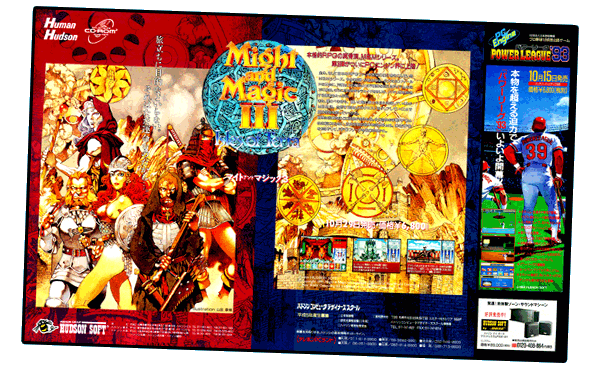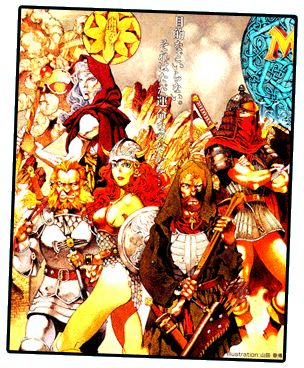The gorgeous Might & Magic III–Isles of Terra Poster #2 (2600x1601 .jpg) ▼ below features some truly wonderful illustrations by Akihiro Yamada. Who is he, you ask? Learn more about Akihiro Yamada. Amongst other things, Akihiro Yamada created exquisite artwork for several PCE titles including Might & Magic, Might & Magic III, Wizardry I & II and Wizardry III & IV…

SANS BASEBALL: If you want to see what this advertisement would look like without a baseball game, feast your eyes upon Might & Magic III–Isles of Terra Poster #1 (2600x1623 .jpg) ▼ from the November 1993 issue of Gekkan PC Engine Magazine.
STRANGE BEDFELLOWS: With a release date of 10.15.1992, Power League '93 steals a slender strip of real estate from Might & Magic III (with a later release date of 10.29.1992). The awkward pairing of Might & Magic III with Power League '93 in this advertisement—indeed, when was the last time you saw an RPG paired with a baseball game?—is not as jarring as it should be. Why? Because the artwork for Power League '93 is tastefully executed (especially for a sports title!).
Sadly, the art for Power League '93 is uncredited. Is there any chance that the Power League '93 illustration is the work of Akihiro Yamada, too? Initially, I simply assumed that Hudson had commissioned a different artist to provide baseball-themed artwork that would complement Yamada's aesthetic. Now I am no longer certain. The baseball illustration has some charm of its own.
 HUDSON SOFT BY BOSE…
HUDSON SOFT BY BOSE…
BOSE has long-marketed itself as a purveyor of premium audio products, with a price to match. Now, whether or not Bose's price tag is justified can be debated another day. Today we examine how BOSE targeted niche audiences (i.e., audiophiles who played video games) to sell their wares. Indeed, for a mere ¥89,000 you could bathe your ears in the glorious soundtrack (.mp3 ▼) from the PCE port of Might and Magic III–Isles of Terra prominently featured in the first ad of the issue.
¥89,000 was roughly equivalent to $870 USD in 1993. To put this figure in perspective, the BOSE subwoofer + speaker + amplifier system sold for more than twice the price of a new DUO-R (¥39,800, ~$386 USD) in early 1993. Now, if you wanted to upgrade the aural experience of a video game console, there were certainly cheaper alternatives to BOSE available.
To make a profit, BOSE was happy to sell "premium" products (with higher profit margins) to smaller, niche markets. BOSE recognized that a person who could afford an expensive console might be tempted by an expensive soundsystem as well.
SPECIFICATIONS: 50W 13 cm subwoofer, 20W 5.7 cm satellite speakers, two-channel stereo amplifier model PAM-4H.
Continued below…
WORK IN PROGRESS…▲
…

Detail: …
…
▲
Return to top of page…